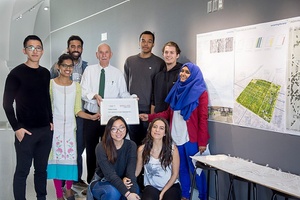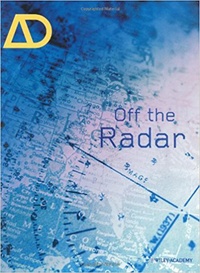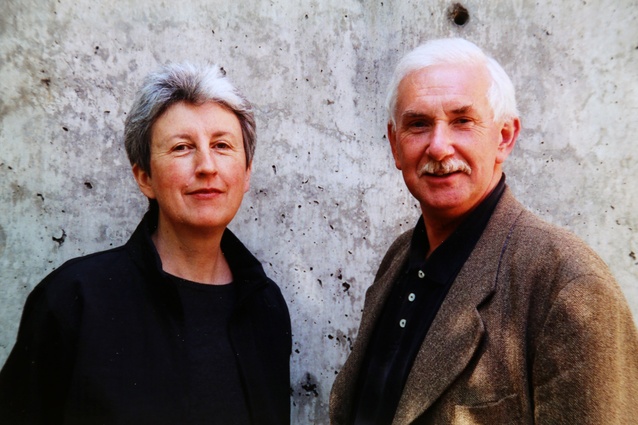Practice through scholarship: Brian Carter and Annette LeCuyer
Amelia Melbourne-Hayward talks to Brian Carter and Annette LeCuyer, the 2017 International Architects in Residence at the University of Auckland.
Professors of Architecture at the University of Buffalo, the State University of New York, the couple taught a postgraduate design studio during their time in residence, and presented a double-handed talk at the Fast Forward 017 spring lecture series.
Amelia Melbourne-Hayward: Where did you both begin your journey in architecture?
Brian Carter: I studied at the Nottingham School of Architecture in England. Before going to graduate school at the University of Toronto I worked for several years in practice in London and in Africa, became a registered architect and was elected an Associate of the Royal Institute of British Architects.
Annette W. LeCuyer: Initially I studied Fine Arts in Colorado and then worked in Europe as a journalist for McGraw-Hill. I was asked to cover construction news and this led me to architecture. I studied in the graduate program at the Architectural Association in London and was fortunate to be there at a particularly lively time. Rem Koolhaas, Peter Cook, Zaha Hadid and Christine Hawley were all teaching there and Alvin Boyarsky was head of the school.
AMH: Annette, you went on to work in London with Fosters and Allies & Morrison while Brian was working with Arup. What was that like?

AWL: I had the opportunity to work on some significant projects in both offices. At Fosters I worked on the Hong Kong and Shanghai Bank Headquarters and Stansted Airport, and on other important projects in England. At Allies & Morrison, I led a team that designed an award-winning building in the heart of London and another that developed a scheme for Newnham College at Cambridge University.
BC: We were both able to do very interesting work in practices where there were fascinating and demanding clients as well as architects who were enthusiastic about working across disciplines. This prompted collaborations with engineers and cost estimators, environmental designers and specialists in materials. Also, we both worked in practices that were engaged in education.
AMH: Why did you choose to leave London?
AWL: While we were working in London we were invited to teach a graduate design studio at the University of Michigan and a subsequent invitation to join the faculty there was compelling.
BC: We had both travelled widely and were inspired by North America. The school of architecture at Michigan has a significant history – Eliel Saarinen taught there and both Raoul Wallenberg and John Dinkeloo were graduates. The opportunity to be there and play fundamental roles in the advancement of the school as teachers and as chair of the Architecture Program was too good to miss!
AMH: Currently you are both Professors of Architecture in Buffalo. What is it like working at the State University of New York and in the city?
BC: After teaching at Michigan for eight years we were invited to join the faculty in Buffalo. I was also appointed dean of the School of Architecture & Planning there. The State University of New York was founded to provide affordable education – something that we had both benefitted from and believe in.
The program in Buffalo is the only accredited architecture program in the SUNY system and attracts a wide range of students, many who come from New York City. They are familiar with cities and aware of their importance as a focus for design and social interaction and many are familiar with the potential of materials and systems of construction. The school in Buffalo has a large, well-equipped workshop and digital fabrication labs that enable students and faculty to design and build.

AWL: We have a very diverse student body in Buffalo and many are first-generation Americans. It is an excellent mix of students who are extremely energetic and enthusiastic.
BC: The City of Buffalo, once one of the wealthiest in America, has a significant urban structure and was planned by Ellicott and Olmsted. It also has an extraordinary collection of outstanding buildings – buildings designed by H.H.Richardson and Louis Sullivan, Wright, Bunshaft, Yamasaki, Durrell Stone, Abramovitz, Eliel and Eero Saarinen and, more recently, Toshiko Mori and Deborah Berke. As a consequence it is a remarkable place to teach and learn about architecture!
AMH: What brought you both to New Zealand?
BC: In 2017 we were invited to be the International Architects in Residence at the University of Auckland. We were familiar with this program, which has brought notable architects from around the world to work with architecture students at the university and meet with professionals. We were flattered to be invited and spent almost a month teaching a graduate design studio in Auckland and giving public lectures throughout the country.
AMH: What did that work focus on?
AWL: Our studio examined the work of contemporary artists as a prelude to designing an art museum for a site on the University of Auckland campus. Our public lecture, entitled ‘Skin & Bones’, was based on professional experiences and the academic research that we have developed through writing about architecture. I teach both design and construction but encourage students to consider the two as highly integrated.
BC: Working with Arup, an integrated, multi-disciplinary global practice, I became increasingly interested in the bones of a building. They make up skeletal frameworks that create structures in buildings but the ‘bones’ also include spatial and environmental systems.
In practice, architects often work in open spaces alongside other disciplines and I found that made the different members of the team more aware of the different issues that influence the design of a building and shape architecture.
AMH: You have both also written extensively about architecture and design. What prompted that?
AWL: As I mentioned earlier, I worked as a journalist before studying architecture, so perhaps it is not so surprising that I have continued to write. We both have an interest in making architecture more accessible and, when we began teaching in North America, we wanted to make books for students and people interested in design that were affordable and could help build an appreciation of architecture, books and libraries.
On arriving at the University of Michigan, we discovered two significant annual lectures that celebrated architecture. Over the years they had brought some of the world’s leading figures to speak on the campus and we suggested that the lectures be documented. This led to the creation of a series of publications called the Michigan Architecture Papers.

BC: Then in Buffalo, we went on to establish BUFFALO books – a series that was made with international architects and academics including Steven Holl, Thom Mayne, Sheila O’Donnell and John Tuomey, Shim Sutcliffe and Toshiko Mori.
AMH: You edited a special issue of Architectural Design called ‘Off the Radar’ that explores architecture in far-flung places around the world. What drew you both to this topic?
BC: There is a lot of very good work by architects around the world that is not immediately visible; professional publications often focus on familiar places. Yet good architecture is everywhere and ‘Off the Radar’ developed out of a conversation with an editor who had an interest in highlighting excellent work from around the world.
AWL: That edition of AD was published in 2003 and documented work in places including South America, Asia, New Zealand, Canada and Africa. The internet now enables people to be more connected and for example, while buildings in Burkina Faso designed by the architect Francis Kéré were not readily accessible to tourists, the dissemination of information about that work, both digitally and through publications, has created a more comprehensive understanding of architecture and design both in that remote setting and more widely.
AMH: Are there differences between the ways that architects work in the United Kingdom and in North America?
AWL: Practices tend to be more specialised in the USA than in Europe. That is partly influenced by considerations of architecture as a business model. Architectural practices in the USA tend to focus on the design of a particular building type or types. In contrast, in London we both worked in offices that designed a wide range of buildings.
BC: There are also fewer publications about architecture and design in North America than in Europe.
AWL: In North America there are also not so many design competitions as in the UK or in Europe, and this shapes practice. Because many of the competitions in Europe are open, they attract young designers from many different places, which makes it possible for emerging practices to realise projects that they may otherwise not be commissioned to design. It also helps to build the portfolios of those practices and provide access to other levels of work.
BC: And as there are numerous publications, often multiple entries in competitions are published and, as a result, the work of particular young architects becomes more widely known.
AMH: You have both been described as advocates for architecture. Do you think there is an even greater need now for architects to promote their work and that of the profession?
BC: Absolutely! If you think about the range, quality and thoughtfulness of the work that is being designed by architects in New Zealand at the moment, there are many benefits for different communities. Since we have been in New Zealand we have seen inspiring and original work that certainly deserves to be more widely known and appreciated!
AMH: Finally, what advice do you have for couples that work together in architecture?
AWL: We were laughing with our students in Auckland as we talked about our work in practice. When we worked in different offices, we sometimes found ourselves working on similar projects, adjacent sites or the same competitions. Not being able to talk with each other about our work was sometimes taxing!
BC: We have also worked together on projects of our own outside of the offices and that was encouraging. The projects were modest but helped to build communities. We have also worked together on several design competitions too – and with some successes! There are many couples who work together in architecture – the design of buildings is always a collaborative activity. However, we rarely cook together!












